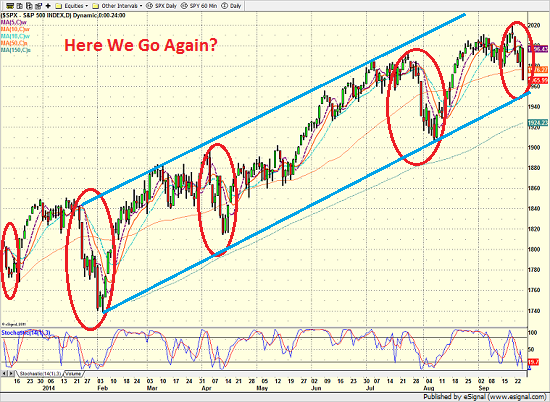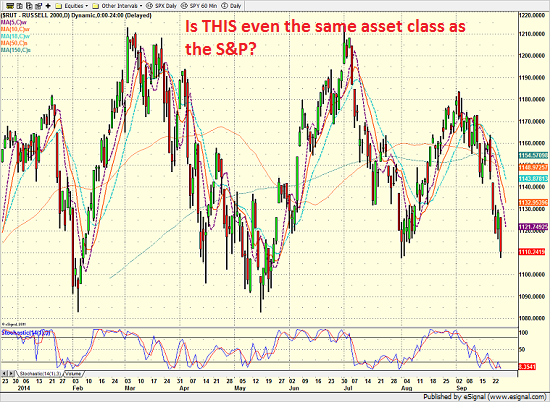On Wednesday, stocks blasted higher on the back of Super Mario singing a dovish song, word that China was about to sack the head of its central bank in favor of someone more modern, and not one, not two but three Fed Governors suggesting that the Fed would likely take their time when it comes to raising rates.
Just like that, the worries about the effects of a rising dollar, where rates might go next, and all things geopolitical were put on the back burner. Stocks recovered all of Tuesday's losses as well as some of Monday's decline on Wednesday, and it looked like the bulls were back in business.
But a funny thing happened on the way to the rally recovery on Thursday. In short, traders forgot about all the good stuff from Wednesday and the market got blasted. Technical levels were broken. Good charts turned into bad charts. The league-leading NASDAQ suddenly looks sick. And the much-maligned Russell 2000 smallcap index continued diving, winding up near the low of the year.
For the record, the Russell is now down 5.5 percent on the month and 4.5 percent on the year. So anyone thinking that the S&P's "healthy" advance was representative of the overall market has another thing coming. Heck, the Dow is only up 2.2 percent in 2014.
Frankly, the charts below really tells the story of this market. First, as indicated on the chart of the S&P 500, it appears that yet another pullback - the fifth in the last 10 months - is underway.
S&P 500 - Daily

And then, as has been discussed, the divergence on the chart of the Russell 2000 grows more glaring with each passing day. And frankly, these two charts don't even look like the same asset class.
Russell 2000 - Daily

The issue here is that such divergences tend to be present during major tops in the stock market.
Another big data point to consider on the subjects of divergences and narrow leadership is the fact that, according to Bloomberg, 47 percent of the stocks on the NASDAQ are currently down 20 percent or more from their peaks in 2014. And again, narrow leadership is another classic indicator of a market top.
It should be pointed out that such an occurrence when the 200-day is rising has been a pretty good buy signal - but that doesn't stop the press from fawning all over the possibility of something REALLY bad happening.
Why The Dive?
When the stock market makes a big move in either direction, there is usually a reason. However, Thursday's dance to the downside did not have any single catalyst. The selling seemed to be a culmination of a bunch of things, some of which include:
- Thursday was the last day a position could be sold in order to get it off a manager's "book" by the end of the quarter (i.e. window undressing)
- The U.S. dollar continued its joyride to the upside, hitting a 4-year high
- BoE's Carney said the economy is getting closer to where rates will need to start rising
- Russia basically said, "You sanction us, we will seize your stuff"
- ISIS warned of terrorist attacks on U.S. and France soil targeting subways, trains, buses
The internal components of Durable Goods report suggests GDP might be hotter than expected, causing traders to worry again about the Fed raising rates sooner than anticipated
- S&P broke two important technical levels: (1) near-term support at 1980 and (2) its 50-day moving average
- Ditto for the NASDAQ
- There was talk of a "large institutional seller" exiting positions in 200 stocks
- Credit risk was in focus as high yield bonds broke down (see symbols JNK, HYG)
- The Yen was heading in the wrong direction again (the Yen-Carry trade remains a thing)
- There were rumors that a hedge fund was in trouble
- The action in commodities - although tied to the dollar's rise - continues to cause growth concerns
- Apple's iOS 8 debacle also created some negative sentiment
Taken alone, none of the above would normally warrant significant selling in stocks. However, these days, once a trend in the market gets started, the computers jump on board and ride the wave for all its worth. And in my humble opinion, this is why so many moves (January 24, April 10, July 31 and yesterday for example) become exaggerated on an intraday basis.
The Big Question
The question of the day, of course, is if the current selloff is "THE" correction that everyone under the sun has been looking for. In fact, a former Federal Reserve economist and fellow CONCERT Wealth Management Investment Committee member posed that very question to the committee via email after the close Thursday.
The conclusion was that while no one can be certain whether or not this is THE correction, the indicators DO suggest that this is a time to play the game less aggressively. So, the bottom line is that now is the time to let price be your guide. Unlike so many indicators, price, by definition, cannot deviate from itself and therefore, will tell us when THE correction is upon us.
© 2025 Benzinga.com. Benzinga does not provide investment advice. All rights reserved.
Trade confidently with insights and alerts from analyst ratings, free reports and breaking news that affects the stocks you care about.